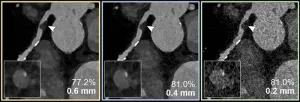(Press-News.org) BLOOMINGTON, Ind. – In the classic Disney film “Beauty and the Beast,” Lumière, the candelabra character, famously sings with Mrs. Potts, a tea pot, “Be our guest, be our guest. Put our service to the test. Tie your napkin round your neck, Cherie, and we provide the rest.”
When the 1991 Oscar-nominated song co-written by Indiana University alumnus Howard Ashman was released, it hardly seemed realistic that a product could sing its own praises and sell itself to consumers. But artificial intelligence today makes it possible and new research from the IU Kelley School of Business finds that it can be a winning retail strategy.
Alan Dennis, professor of information systems and the John T. Chambers Chair of Internet Systems at the Kelley School, believes that it won’t long before products are selling themselves. Visual design technologies have rapidly improved over the past decade. Digital assistants such as Siri and Alexa and support chatbots have become ubiquitous.
“Companies have long used cartoon-like characters to sell products. We are familiar with the ‘M&M spokescandies,’ for example,” Dennis said. “But adding human features to a product can be a powerful way to influence consumers’ perceptions and decision making, because it can trigger anthromorphism.
“When we hear or see an inanimate object that has human features, our brain automatically ascribes human form to it even though we rationally know the object is not human. Anthromorphism changes how we think and behave toward an object, making us like it more,” he added. “Initial evidence suggests that not all products can trigger this; people are more likely to anthromorphize complex products.”
To test this idea, Dennis asked about 50 undergraduate students to assume the role of a new master’s candidate and told them their program required them to purchase a laptop computer, a camera and a television. They were required to bid for the products in an eBay-style auction site.
The researchers used a two-minute video to deliver the “human” element of each product and participants couldn’t bid until it was finished. They used a professional graphic to add human physical characteristics – such as eyes, a mouth and nose – human-like movements – such as blinking and mouth movement while talking. Each product spoke in the first person.
In addition to tracking each person’s willingness to pay, their cognitive processes were measured using an Emotiv EPOC EEG headset. Findings included:
People were willing to bid about 20 percent more for the more complex product – the laptop – when it was displayed with the human attributes, as compared with those who only learned about it through a static web page or with a video presenting just a slideshow.
In contrast, displaying the less complex products – the television and camera – in the same anthromorphic way had no effect on the amount bid.
The EEG data showed that presenting a product with the human elements and features triggered more cognition in the parietal lobe of the brain, which plays a key role in our understanding of the world around us. It also helps us understand where we are in relation to other things that your senses detect around us.
This recognition within brain was not a universal response. The data showed that ascribing human characteristics to the non-human products triggered different responses, depending the complexity of the product. Many respondents exerted more effort to suppress the “cartoon agent” as irrelevant in the case of the television and the camera.
The results suggest that people are more likely to amthromophize a product if it already has some human-like functionalities, such as the ability to respond and speak in a human voice, present some level of human knowledge, or have some autonomy in how it functions.
“Our research shows that there are important boundary conditions in the effects of displaying products in an anthromorphic form,” Dennis said. “Our results show that anthromorphic displays lead to different cognition and different willingness to pay for more complex products, but not less complex products … Our results suggest that adding a face, movement and human speech are useful in designing the display of more complex products.”
The paper, “Selling myself: Anthropomorphic products in electronic commerce,” appears in the journal, Decision Support Systems,” and was co-authored by Dennis and Lingyao “Ivy” Yuan, associate professor of information systems and the Kingland Systems Graduate Director of Business Analytics at the Debbie and Jerry Ivy College of Business at Iowa State University. She earned her PhD in information systems from the Kelley School of Business.
END
If your TV spoke to you, would you buy it? Study finds people spend more on some “talking products”
2024-02-20
ELSE PRESS RELEASES FROM THIS DATE:
Photon-counting CT improves coronary artery disease assessment
2024-02-20
OAK BROOK, Ill. – Ultrahigh-spatial-resolution photon-counting detector CT improved assessment of coronary artery disease (CAD), allowing for reclassification to a lower disease category in 54% of patients, according to a new study published today in Radiology, a journal of the Radiological Society of North America (RSNA). The technology has the potential to improve patient management and reduce unnecessary interventions.
Coronary CT angiography is a first-line test in the assessment of coronary artery disease. However, its diagnostic value is limited in patients with severe calcifications, or calcium ...
Annual breast cancer screening beginning at 40 saves lives
2024-02-20
OAK BROOK, Ill. – Annual breast cancer screening beginning at age 40 and continuing to at least age 79 results in the highest reduction in mortality with minimal risks, according to a new study published today in Radiology, a journal of the Radiological Society of North America (RSNA).
Breast cancer is the second most common cause of cancer death for women in the U.S. Despite research demonstrating that consistent participation in screening mammography can reduce breast cancer deaths by 40%, only 50% or less of eligible women actually participate in annual screening.
“There is an ongoing debate over the recommendations for breast cancer screening, specifically ...
NYU’s Jinyoung Park and SueYeon Chung win Sloan Foundation Research Fellowships
2024-02-20
Two New York University faculty have been awarded fellowships from the Alfred P. Sloan Foundation: SueYeon Chung, an assistant professor at the Center for Neural Science, and Jinyoung Park, an assistant professor at the Courant Institute for Mathematical Sciences.
The fellowships recognize “exceptional U.S. and Canadian researchers whose creativity, innovation, and research accomplishments make them stand out as the next generation of leaders,” the Sloan Foundation said in announcing this year’s ...
U of T-led study finds positive support from parents and clinicians for pediatric cancer pain management app
2024-02-20
A recent study led by Assistant Professor Lindsay Jibb of the Lawrence Bloomberg Faculty of Nursing and Scientist at The Hospital for Sick Children (SickKids) found that parents of young children with cancer, along with pediatric cancer clinicians are in favour of an app-based solution that Jibb and her team are creating, to help parents manage their child’s cancer pain at home.
The study published in PLOS Digital Health showed that parents and clinicians not only found the pain management app to be helpful and safe, but also provided them with a sense of empowerment.
“The ...
Generating 'buzz' about new products can influence their success
2024-02-20
BINGHAMTON, N.Y. -- The way companies announce new products or build up hype can often influence their success once those new products hit the market, according to new research from Binghamton University, State University of New York. Whether it's an upcoming blockbuster movie or a new rollout from major companies like Coca-Cola or Apple, the new research shows how companies might use this type of preannouncement marketing to their advantage.
How often have you watched trailers for an upcoming movie and thought, “I can’t wait to see that,” when it hits theaters ...
The immune system’s moonlighters
2024-02-20
Our immune system is remarkably powerful. It quickly assembles teams of cells to eliminate threats inside our bodies. But sometimes, it hits the wrong target. Autoimmune diseases like lupus and multiple sclerosis result from friendly fire—immune cells attacking healthy tissues and organs by mistake. New treatments and therapeutic targets are direly needed for these conditions.
Now, Cold Spring Harbor Laboratory (CSHL) Professor Christopher Vakoc may have stumbled upon a new therapeutic target—one hidden in plain sight. Vakoc and his team discovered that IκBζ, a well-studied protein in the immunology ...
Geographic disparities in access to addiction treatment medication may be linked to race, ethnicity
2024-02-20
PITTSBURGH, Feb. 20, 2024 — Buprenorphine, a life-saving medication for opioid use disorder, is far less accessible in geographic areas of the United States with racially and ethnically diverse populations than in predominantly white areas, according to a new study of pre-pandemic data led by health policy scientists at the University of Pittsburgh School of Public Health published today in Journal of Addiction Medicine.
The study is among the first to examine buprenorphine access at the local, sub-county level, and the findings point to lack of access to medications for opioid use disorder as a potential ...
The director of the U.S. National Science Foundation on the future of AI
2024-02-20
In an editorial, Sethuraman Panchanathan, director of the U.S. National Science Foundation (NSF), calls for the responsible and equitable development of artificial intelligence (AI) and promises to use the agency’s resources to work toward democratizing AI research. NSF spends $800 million on AI research in the public interest each year. Panchanathan summarizes some of the benefits AI can offer to scientific research—from accelerating discovery to automating routine tasks—but emphasizes that AI must be safe and accessible. Toward that end, NSF and its partners launched the National Artificial Intelligence Research Resource ...
Unlocking the energetic secrets of collective animal movement: How group behavior reduces energy costs in fish
2024-02-20
Many animals, including apex predators, move in groups. We know this collective behavior is fundamental to the animal’s ability to move in complex environments, but less is known about what drives the behavior because many factors underlie its evolution. Scientists wonder, though, if all these animals share a fundamental drive such as for mating, safety, or perhaps even to save energy.
“The keyword is perhaps,” said Yangfan Zhang, postdoctoral researcher in the Department of Organismic and Evolutionary Biology (OEB) at Harvard, “because no one has actually measured this and compared it directly across all animal groups, mainly ...
Wide variation in rates of police killings suggests unnecessary deaths
2024-02-20
One in three police homicides could have been avoided without endangering police or the public, according to a study. Eight percent of all homicides of adult men in the United States are committed by police. Using data from 2008–2017 from the National Officer-Involved Homicide Database, Josh Leung-Gagné compared police homicide rates across the 711 local police departments serving 50,000 or more residents in the United States. One explanation for differing rates of police killings is that some jurisdictions are riskier than others, which necessitates ...







